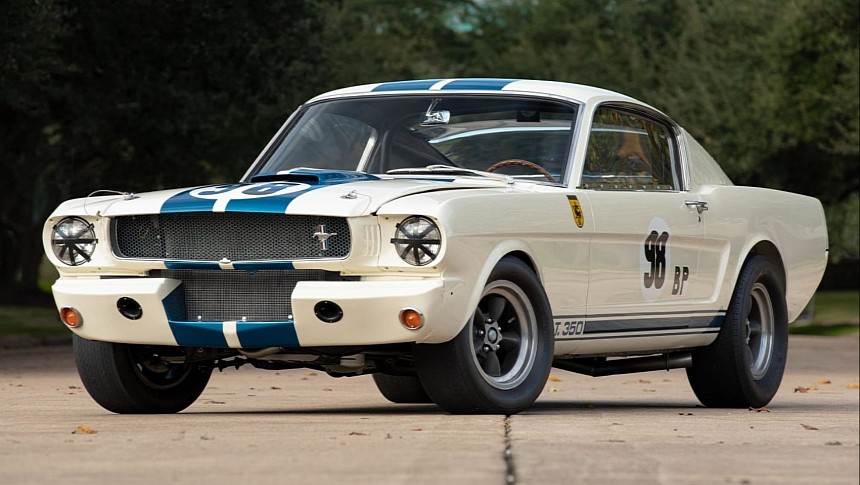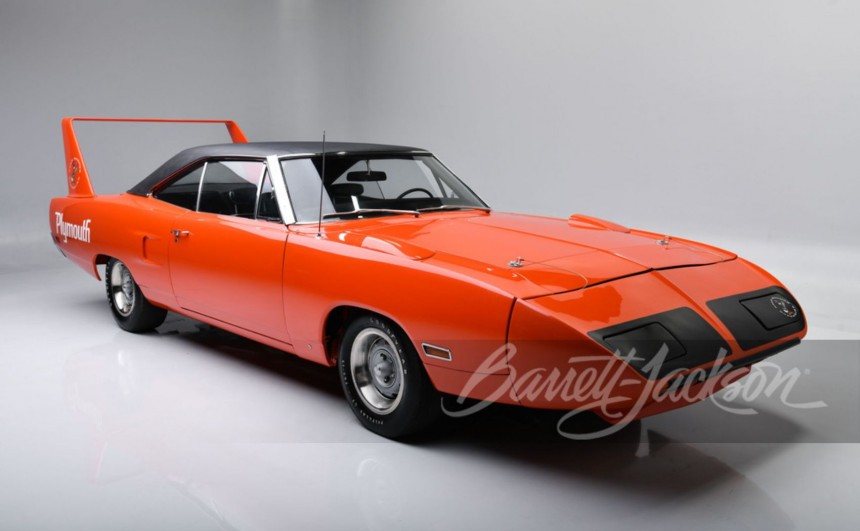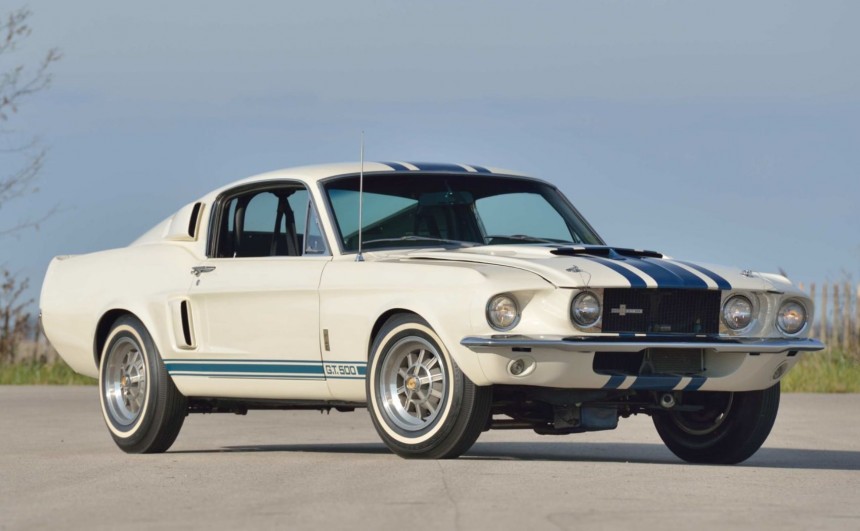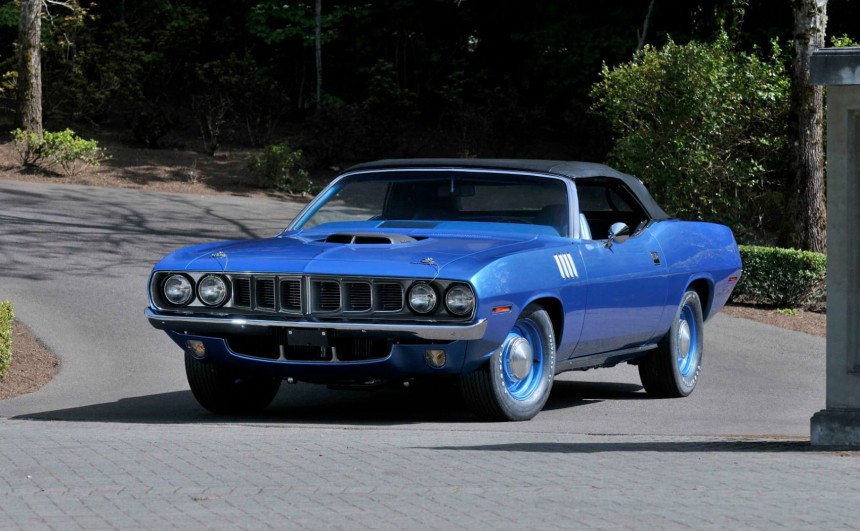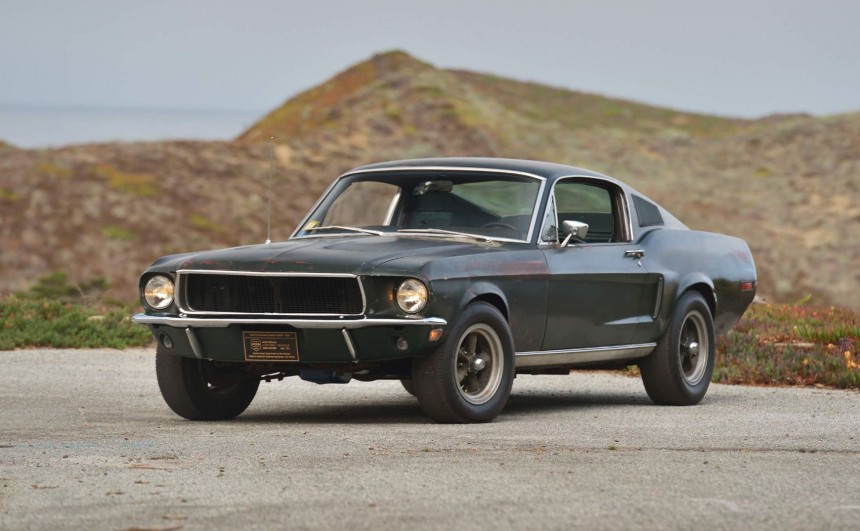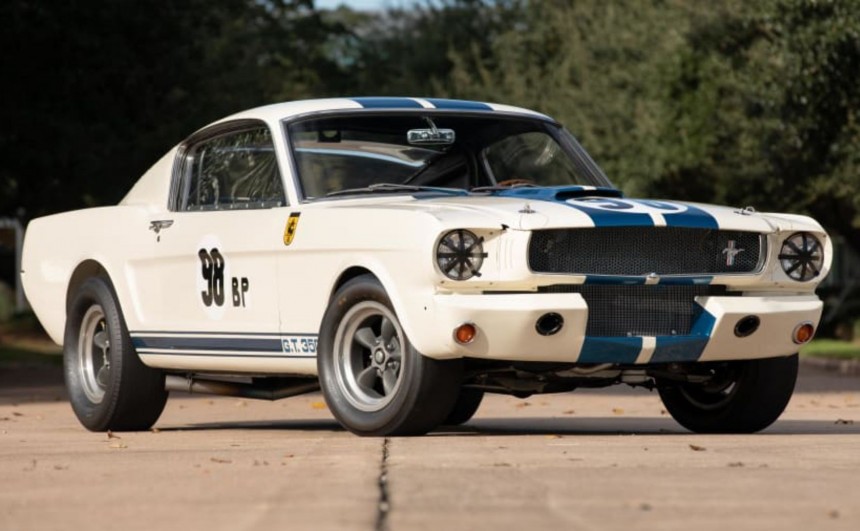These days, almost all the surviving muscle cars from the 1960s and 1970s are prohibitively expensive. Still, these five super-rare rides took the meaning of expensive to a whole different dimension, fetching seven figures at auctions in recent years.
Some folks out there think that classic muscle cars are just humongous, overpowered relics that guzzle too much gas and handle like a brick on wheels.
Though that might be true to some extent, the vast majority of car enthusiasts see them as the best, most iconic products of the American automotive industry.
Yes, they're tough to tame, unsafe, and were developed during a time when carmakers simply didn't care about fuel economy or the environment, but this exact outcast mantra is what made - and still makes people fall in love with them.
Muscle cars were initially affordable to the average person - which is another reason why they were so popular. Then, as the fuel crises of the 1970s forced people to move on to more efficient cars, the value of these surviving icons dropped significantly. During the late 1970s and 1980s, you could get a legendary muscle car for a few hundred bucks, as many owners were desperate to get rid of their gas guzzler.
But, a few decades of painfully-boring cars later, enthusiasts began realizing just how special these cars really were and became willing to pay big bucks to own one. This resurgence of the classic muscle car led to millions of dollars being spent on some of the rarest examples that were lucky enough to survive.
The first entry on our list is one of the very few muscle car homologation specials. It came into being as Mother Mopar was getting its behind whooped in the 1969 NASCAR season by the aerodynamically-efficient Ford Torino Talladega, despite lining up its own so-called aero car: the Dodge Charger Daytona.
Plymouth engineers took note and created their own, much-improved version of the Daytona for the 1970 season, basing it on the mass-produced Road Runner. But, to gain homologation, they had to produce a batch of street-legal cars, and thus the Superbird was born.
In road-legal guise, the Superbird was powered by the legendary 426-ci (7.0-liter) street HEMI which came with dual four-barrel carbs and produced 425 hp.
With its elongated nose and huge rear spoiler, the homologation special was an instant hit among muscle car fanatics. Though there's some debate about the actual production figure of this legendary ride, it's widely believed that a little over 2,000 units were sold by Plymouth dealerships, and about half of those are still around today.
One of the surviving Superbirds finished in the special high-impact EV2 Tor Red paint was kept nearly brand-new by its past owners, so when it went under the hammer at a Barrett-Jackson auction held in Las Vegas last year (2022), it fetched no less than $1.65 million. It was the highest amount ever paid for a 1970 Superbird and one of the highest paid for any classic muscle car.
The late Carroll Shelby remains one of the most influential people in the history of the American automotive industry. He was responsible for turning Ford's slumping GT40 project into a legendary Le Mans-winning race car, transformed the first-generation Mustang from a secretary's car into a near-flawless high-performance car, and created the famous Shelby Cobras - arguably the greatest sports cars ever produced in the US during the 1960s.
In 1967, Shelby and his partners at Ford were celebrating their second consecutive Le Mans win with the GT40, and they also released the finest Shelby Mustang to date: the GT500.
That year, Carroll Shelby - who was also the official West Coast distributor for Goodyear tires - also went on to build one of the most insane cars of the era.
Invited to promote Goodyear's new line of Thunderbolt economy tires at a high-speed test facility near San Angelo, Texas, Shelby decided to kill two birds with one stone by also taking the opportunity to promote the new GT500.
Instead of slapping a set of Thunderbolts on a stock GT500, he asked Ford to lend him a Le Mans-spec 427 V8 from a GT40 and tasked chief engineer Fred Goodell to squeeze it inside a GT500's engine bay. Rated at around 650 hp (or 540 hp according to some sources), the engine helped the one-off dubbed Super Snake put on quite a show as it blazed past the crowd at 170 mph (273 kph).
Shelby then researched the possibility of starting a limited-production run of the GT500 Super Snake, but unfortunately, that never happened.
The one-off survived, changing owners several times throughout the decades. With only 26,000 miles (41,843 km) on the odometer and outfitted with the only surviving set of Thunderbolts, the Super Snake was auctioned off by Mecum in 2019, fetching $2.2 Million.
When the Chrysler Corporation introduced the street version of the NASCAR-bred 426 HEMI in its production vehicles, it became a game-changer. Conservatively rated at 425 hp (but capable of more), the massive V8 made the Mopars it powered virtually unbeatable in a straight line.
Though it was initially available in 1966 on intermediate models, two years later, it could also be had inside the engine bay of the smaller, lighter Barracuda pony car. The Elephant engine continued to be the Barracuda's top-of-the-line engine choice even after the model was completely redesigned for the 1970 model year.
The third and last iteration of the 'Cuda is hailed as one of the most beautiful cars built during the original muscle car era, and when equipped with the HEMI, it's also one of the most powerful.
But, since the HEMI was discontinued after the 1971 model year, only 780 third-gen HEMI 'Cudas were ever built. Of these, just 21 were convertibles (14 built in 1970 and seven a year later).
Considering these low production numbers and enthusiasts' fondness for the third-gen, surviving 1970 and 1971 HEMI, 'Cudas became some of the high-value muscle cars on planet Earth.
The '71 example above holds the record for the most expensive 1971 HEMI 'Cuda ever sold at auction, switching owners in 2014 at a Mecum event for the eye-watering bid of $3.85 million.
More recently, another '71 hit the auction block, with the highest bid reaching $4.8 million. However, the owner's reserve was not met, as he reportedly wanted no less than $6 million.
Ford introduced the Mustang in 1964, and even though the company was expecting it to do well in terms of sales, it never envisioned just how big of a hit it would become.
Apart from its classy European styling, unprecedented variety of options, and competitive pricing, the 'Stang became Ford's best-seller also due to the company's strong marketing campaign.
The pony car was featured in dozens of entertaining TV ads and was also featured in Holywood movies. Its most prominent big-screen role was in Peter Yates' 1968 action thriller Bullitt where it took part in one of the most epic car chases ever featured in a movie.
Driven by the legendary Steve McQueen, who played the leading role of detective Frank Bullitt, the Mustang used in the movie was a Highland Green 1968 GT Fastback equipped with the 390-ci (6.4-liter) V8. Actually, the cast used two identical cars, both of which were customized by Holywood race car builder and McQueen's close friend, Max Balchowsky.
The modifications included stronger springs and shocks, modified cylinder heads, bigger carbs, and electronic ignition systems. Even the stock mufflers were swapped with straight pipes to make the car sound more menacing.
One of the Bullitt Mustangs was damaged beyond repair during the making of the movie, but the other one survived and changed owners multiple times. For years, it was driven daily, and at some point, it spent some time in a garage before the owner's son brought it back to life.
As you can see in the photo above, it was never fully restored and only received enough attention to get it running again. Ultimately, the owner decided to part ways with the legendary movie car, which was auctioned at a Mecum event in 2020 for a bid of $ 3.74 million.
As I mentioned before, Carroll Shelby was responsible for turning the popular pony car into a true high-performance beast soon after the 'Stang officially hit the streets.
Apart from the road-legal GT350s sold through the California-based company's dealerships starting with the 1965 model year, Shelby and his crew also built a batch of 34 competition-spec cars dubbed GT350R that won the Sports Car Club of America's (SCCA) B-Production class for three straight seasons, embarrassing Chevy's Corvette in the process.
The GT350R program started with a prototype built and extensively tested by a select team that included engineer Chuck Cantwell, development driver Ken Miles, and of course, Carroll Shelby himself.
Nicknamed Ken Miles' Flying Mustang, the prototype with the vehicle identification number (VIN) SFM5R002 (or 5R002, for short) was based on a stock 1965 Mustang Fastback body shell, receiving a multitude of modifications which included an extensively beefed up 289-ci (4.7-liter) K-Code V8 that could make around 350 hp.
Lightened to 2,550 pounds (1,156 kg) and capable of reaching 60 mph (97 kph) from a standstill in five seconds flat, the prototype became the first GT350R to win an official race with the legendary Ken Miles behind the wheel. It paved the way for the other 34 customer cars, and according to virtually every Mustang historian, it's the most historically-significant member of the iconic model line.
Unlike other prototypes, the 5R002 GT350 survived and, at some point, was painstakingly restored to its original state. In 2020, it was auctioned off by Mecum, fetching a whopping $3.85 million. Curiously, it went under the hammer again just two years later, but this time it sold for "only" $3.75 million.
Though that might be true to some extent, the vast majority of car enthusiasts see them as the best, most iconic products of the American automotive industry.
Yes, they're tough to tame, unsafe, and were developed during a time when carmakers simply didn't care about fuel economy or the environment, but this exact outcast mantra is what made - and still makes people fall in love with them.
Muscle cars were initially affordable to the average person - which is another reason why they were so popular. Then, as the fuel crises of the 1970s forced people to move on to more efficient cars, the value of these surviving icons dropped significantly. During the late 1970s and 1980s, you could get a legendary muscle car for a few hundred bucks, as many owners were desperate to get rid of their gas guzzler.
But, a few decades of painfully-boring cars later, enthusiasts began realizing just how special these cars really were and became willing to pay big bucks to own one. This resurgence of the classic muscle car led to millions of dollars being spent on some of the rarest examples that were lucky enough to survive.
1970 Plymouth Superbird – $1.65 Million
Plymouth engineers took note and created their own, much-improved version of the Daytona for the 1970 season, basing it on the mass-produced Road Runner. But, to gain homologation, they had to produce a batch of street-legal cars, and thus the Superbird was born.
In road-legal guise, the Superbird was powered by the legendary 426-ci (7.0-liter) street HEMI which came with dual four-barrel carbs and produced 425 hp.
With its elongated nose and huge rear spoiler, the homologation special was an instant hit among muscle car fanatics. Though there's some debate about the actual production figure of this legendary ride, it's widely believed that a little over 2,000 units were sold by Plymouth dealerships, and about half of those are still around today.
One of the surviving Superbirds finished in the special high-impact EV2 Tor Red paint was kept nearly brand-new by its past owners, so when it went under the hammer at a Barrett-Jackson auction held in Las Vegas last year (2022), it fetched no less than $1.65 million. It was the highest amount ever paid for a 1970 Superbird and one of the highest paid for any classic muscle car.
1967 Shelby GT500 Super Snake – $2.2 Million
In 1967, Shelby and his partners at Ford were celebrating their second consecutive Le Mans win with the GT40, and they also released the finest Shelby Mustang to date: the GT500.
That year, Carroll Shelby - who was also the official West Coast distributor for Goodyear tires - also went on to build one of the most insane cars of the era.
Invited to promote Goodyear's new line of Thunderbolt economy tires at a high-speed test facility near San Angelo, Texas, Shelby decided to kill two birds with one stone by also taking the opportunity to promote the new GT500.
Instead of slapping a set of Thunderbolts on a stock GT500, he asked Ford to lend him a Le Mans-spec 427 V8 from a GT40 and tasked chief engineer Fred Goodell to squeeze it inside a GT500's engine bay. Rated at around 650 hp (or 540 hp according to some sources), the engine helped the one-off dubbed Super Snake put on quite a show as it blazed past the crowd at 170 mph (273 kph).
Shelby then researched the possibility of starting a limited-production run of the GT500 Super Snake, but unfortunately, that never happened.
The one-off survived, changing owners several times throughout the decades. With only 26,000 miles (41,843 km) on the odometer and outfitted with the only surviving set of Thunderbolts, the Super Snake was auctioned off by Mecum in 2019, fetching $2.2 Million.
1971 Plymouth HEMI ‘Cuda Convertible – $3.5 Million
Though it was initially available in 1966 on intermediate models, two years later, it could also be had inside the engine bay of the smaller, lighter Barracuda pony car. The Elephant engine continued to be the Barracuda's top-of-the-line engine choice even after the model was completely redesigned for the 1970 model year.
The third and last iteration of the 'Cuda is hailed as one of the most beautiful cars built during the original muscle car era, and when equipped with the HEMI, it's also one of the most powerful.
But, since the HEMI was discontinued after the 1971 model year, only 780 third-gen HEMI 'Cudas were ever built. Of these, just 21 were convertibles (14 built in 1970 and seven a year later).
Considering these low production numbers and enthusiasts' fondness for the third-gen, surviving 1970 and 1971 HEMI, 'Cudas became some of the high-value muscle cars on planet Earth.
The '71 example above holds the record for the most expensive 1971 HEMI 'Cuda ever sold at auction, switching owners in 2014 at a Mecum event for the eye-watering bid of $3.85 million.
More recently, another '71 hit the auction block, with the highest bid reaching $4.8 million. However, the owner's reserve was not met, as he reportedly wanted no less than $6 million.
1968 Ford Mustang GT "Bullitt" – $3.74 Million
Apart from its classy European styling, unprecedented variety of options, and competitive pricing, the 'Stang became Ford's best-seller also due to the company's strong marketing campaign.
The pony car was featured in dozens of entertaining TV ads and was also featured in Holywood movies. Its most prominent big-screen role was in Peter Yates' 1968 action thriller Bullitt where it took part in one of the most epic car chases ever featured in a movie.
Driven by the legendary Steve McQueen, who played the leading role of detective Frank Bullitt, the Mustang used in the movie was a Highland Green 1968 GT Fastback equipped with the 390-ci (6.4-liter) V8. Actually, the cast used two identical cars, both of which were customized by Holywood race car builder and McQueen's close friend, Max Balchowsky.
The modifications included stronger springs and shocks, modified cylinder heads, bigger carbs, and electronic ignition systems. Even the stock mufflers were swapped with straight pipes to make the car sound more menacing.
One of the Bullitt Mustangs was damaged beyond repair during the making of the movie, but the other one survived and changed owners multiple times. For years, it was driven daily, and at some point, it spent some time in a garage before the owner's son brought it back to life.
As you can see in the photo above, it was never fully restored and only received enough attention to get it running again. Ultimately, the owner decided to part ways with the legendary movie car, which was auctioned at a Mecum event in 2020 for a bid of $ 3.74 million.
1965 Shelby Mustang GT350R – $3.85 Million
Apart from the road-legal GT350s sold through the California-based company's dealerships starting with the 1965 model year, Shelby and his crew also built a batch of 34 competition-spec cars dubbed GT350R that won the Sports Car Club of America's (SCCA) B-Production class for three straight seasons, embarrassing Chevy's Corvette in the process.
The GT350R program started with a prototype built and extensively tested by a select team that included engineer Chuck Cantwell, development driver Ken Miles, and of course, Carroll Shelby himself.
Nicknamed Ken Miles' Flying Mustang, the prototype with the vehicle identification number (VIN) SFM5R002 (or 5R002, for short) was based on a stock 1965 Mustang Fastback body shell, receiving a multitude of modifications which included an extensively beefed up 289-ci (4.7-liter) K-Code V8 that could make around 350 hp.
Lightened to 2,550 pounds (1,156 kg) and capable of reaching 60 mph (97 kph) from a standstill in five seconds flat, the prototype became the first GT350R to win an official race with the legendary Ken Miles behind the wheel. It paved the way for the other 34 customer cars, and according to virtually every Mustang historian, it's the most historically-significant member of the iconic model line.
Unlike other prototypes, the 5R002 GT350 survived and, at some point, was painstakingly restored to its original state. In 2020, it was auctioned off by Mecum, fetching a whopping $3.85 million. Curiously, it went under the hammer again just two years later, but this time it sold for "only" $3.75 million.
